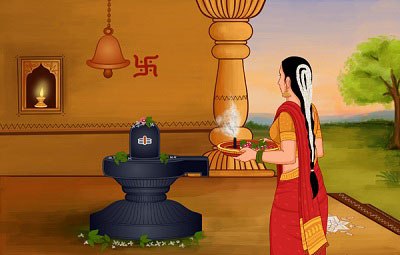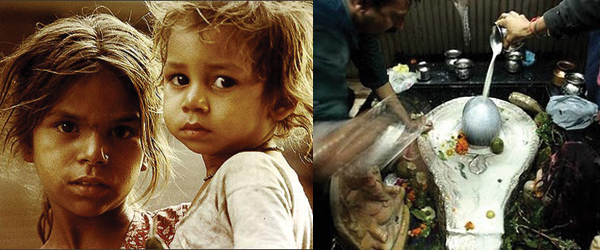इस साल महाप्रसाद का आयोजन २२ फेब्रुवरी २०१५ को शाम ७ से १० बजे तक किया गया है। भक्तों से निवेदन है, कि वह अपना योगदान मंदिर में २१ फेब्रुवरी तक जमा कराएं तथा २२ तारीख को महाप्रसाद का लाभ उठायें।
Tag Archives: mahashivratri
Shivratri SMS – SMS on Mahashivratri
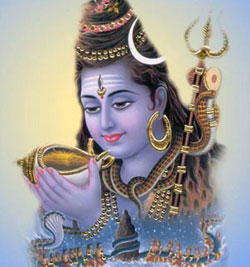 Lord Shiva is one of the Hindu Trinity of Gods. Every year innumerable devotees worship Lord Shiva to emancipate them from their current state of unhappiness and worry. Maha Shivratri is an occasion to shower Lord Shiva with devotion and seek his blessings. Shivratri SMS is a collection that talks about Shiva’s grand presence. You can choose from a range of Mahashivratri SMS and forward the same to your near dear ones.
Lord Shiva is one of the Hindu Trinity of Gods. Every year innumerable devotees worship Lord Shiva to emancipate them from their current state of unhappiness and worry. Maha Shivratri is an occasion to shower Lord Shiva with devotion and seek his blessings. Shivratri SMS is a collection that talks about Shiva’s grand presence. You can choose from a range of Mahashivratri SMS and forward the same to your near dear ones.
Shiva is omnipresent and he is known to grant blessings to anybody who remembers him with honest devotion. These messages talk about the different names of Shiva while some call for his blessings. These SMS will come real useful just in case you know of someone who is an ardent devotee of Shiv Shankar…Brighten their day by being a part of their belief. For this all you need is a simple message.
If you’re looking for a collection of Shivratri SMS, then here’s where your search should end. This long list of SMS will give you all that you wanted. It’s a great collection that expresses just what you wanted to say in a language so simple and easy to understand.
May Lord Shiva bless you with all the best in life. Bring Peace, Success, Health and Well Being in your life and the life of those close to you. Happy Shivratri!!
1. Jai Shiv Onkara Har Shiv Onkara.
Brahma Vishnu Sadashiv Arddhagni Dhara.
Om Hara Hara Mahaadevaa…
May da blessings of Lord Shiva….
Always b with u….!
2. JAI SHIV SHANKAR BHOLENATH!!!
Bless us with da happy & peaceful life
with noble wisdom. May dr be peace in every home!!!
3. Jo Bole Om Namah Shivaya
Sb Kasthon sy Nivaran paye
Happy Mahashivratri 2015
Sacche Dil Sy Jo Shiv Ko Pukr
Khali Haath Woh Kahin Na Javy
1-2-3-4 Shivji ki jai jai kar
4. Shivaratri mnz auspicious darkness.
Devotees mst spend da night of Shivaratri
by chanting with full sincerity da name of
Lord Shiva & ck His divine blessings.
5. SHIV ki jyoti se noor milta hai
sbky dilon ko surur milta hai
jo bhi jaata hai BHOLEY ke dwaar
kuch na kuch zarror milta hai
JAI BABA AMARNATH
6. Shiv ki mahima aparampar! Shiv karte sabka udhar,
Unki kripa aap par sada bani rahe, aur bhole shankar
aapke jivan me khushi hi khushi bhar de.
OM NAMAH SHIVAY
7. Shivam shivakaram shaantham,shivaathmanam
shivothamam,shivamarga pranaethaaram,
pranathosmi sadaa shivamMahaa shivraathri
aashamsakal
Happy Mahashivratri 2015
Mahashivratri Mahaprasad 2014
इस साल महाप्रसाद का आयोजन २ मार्च २०१४ को दोपहर २ से शाम ८ बजे तक किया गया है। भक्तों से निवेदन है, कि वह अपना योगदान मंदिर में जमा कराएं तथा २ तारीख को महाप्रसाद का लाभ उठायें।
Happy Mahashivratri 2014

श्री कल्याणेश्वर शिव मंदिर के भक्तगणों को महाशिवरात्रि कि हार्दिक शुभकामनाएं ।
इस साल हर बार कि तरह महाशिवरात्रि पर सुबह ४ बजे से भक्तों का ताँता लगा हुआ देखा गया। शाम तक श्रद्धालुओं कि संख्या ५०००० तक पहुँचने का अनुमान लगाया जा रहा है। कहा जा रहा है के, बृहस्पतिवार के दिन महाशिवरात्रि का योग ५०० साल बाद आया है। बारिश तथा भीड़ के बावजूद हजारों कि तादाद में नागपुर और आस-पास के इलाकों से श्रध्दालु दर्शन के लिए कतार में खड़े रहे।
भोलेनाथ आपकी हर मनोकामना पूर्ण करें। जय शिवशंकर।
Shivaratri Recipes
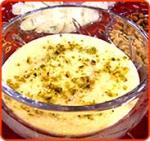
Check out this collection of traditional and delicious Shivaratri Recipes! Since many people observe fast on Mahashivratri, general recipes have been avoided in this section. In case you too have a special recipe for Shivratri do share it with us and help us enhance this site.
List of Shivratri Recipes
» Thandai
» Cashew Nut Barfi (Kaju Katli)
» Saboodana Kheer
» Potato Pumpkin Pancakes
» Shivratri Raita
» Aloo Khichdi
» Aloo Tikki
» Green Gram Fry
» Sweet Yam (Chakravelli)
» Pachi Pulusu (Raw Rasam)
» SagoSaboodana Khichdi
Thandai
Ingredients(makes 8 glasses):
1 cup: Milk
1½ cups: Sugar
1/4 cup: Dried or fresh Rose petals (gulkand variety)
1½ litres: Water
1 tbsp: Almonds
1 tbsp: Kharbooj/Tarbooj seeds skinned (commercially available)
(these are skinned dried seeds of watermelon and cantaloupes)
1 tsp: Peppercorns (whole)
½ tbsp: Khuskhus (poppy seeds)
½ tbsp: Saunf (aniseed)
½ tsp: Cardamom powder or 15 whole pods
½ tsp: Rose Water (optional)
Method:
- Soak sugar in ½ litre of the water used. Keep aside.
- Wash clean all other dry ingredients, except cardamom if using powder.
- Soak in 2 cups of remaining water. Keep aside.
- Allow each soaked item to stand for at least 2 hours.
- Grind all soaked ingredient (not sugar) to a very fine paste.
- Use a stone grinder (manual or electric) if possible.
- When the paste is very fine, mix remaining water.
- Place a strong muslin strainer over a large deep vessel. Or tie a strong muslin cloth over rim of vessel and use to strain.
- Press through muslin with back of palms, extracting the liquid into vessel.
- Add remaining water, a little at a time to extract more.
- Pour – back some of the extract and press, repress.
- Repeat this process till the residue becomes dry and husk-like.
- Add milk, sugar and rosewater to the extracted liquid.
- If using cardamom powder mix it in with the milk.
- Mix well. Chill for an hour or two before serving.
Cashew Nut Barfi (Kaju Katli)
Ingredients: (makes 20 pieces)
200 ml: Milk
250 gms: Cashew nuts
250 gms: Sugar
Silver foil for decoration (optional)
Method:
- Blend together cashews and milk very finely, in a blender.
- Put the paste in a kadhai, add sugar and cook over low flame. Stir till the sugar dissolves and then bring to a boil.
- Continue stirring over medium flame, till mixture collects together and becomes dough-like.
- Remove from flame, cool enough a hit, roll on to a greased surface with a greased rolling pin to ¼ cm/1/8″ thickness.
- Cover with silver foil and cool.
- Cut into diamond shaped pieces and transfer onto a serving dish.
Tip: Those not allowed to eat fats may use singhara flour to dust pin, surface and dough while rolling.
Saboodana Kheer
Ingredients:
4 cups: Milk
1 tbsp: Sago granules
3/4 cup: Sugar
1/4 tsp: Cardamom powder
1 cup: Water
Method:
- Wash and drain sago, keep aside for 10 minutes.
- When moisture is absorbed, loosen grains.
- Heat water. Add sago, bring to a boil while stirring.
- Reduce heat, simmer for 5-6 minutes, and add a tbsp. more water if required.
- Add milk; bring back to a boil.
- Simmer for 5 minutes. Add sugar, cardamom.
- Stir occasionally, simmer till sago granule is cooked, but not mushy.
- Check by pressing it between thumb and finger. It should flatten on pressing.
- Serve hot, with nuts if desired.
Potato Pumpkin Pancakes
Ingredients (makes 8-10 pancakes):
1 no: Large potato
1 big chunk Pumpkin
1 cup: Kootu flour
1/2 cup: Singhara flour
1/4 cup: Curd
2 no: Green chilies
1″ piece: Ginger
1/2 cup: Coriander finely chopped
Oil to shallow fry
Salt to taste
Method
- Run ginger and chilies in a mixer to crush finely.
- Grate potato and pumpkin into a bowl of cold salted water.
- Take flours in a deep bowl.
- Make a well in the centre. Put coriander.
- Press out water from grated veggies completely. Add in centre, with chilli-ginger.
- Add salt, mix everything into an even batter.
- Add some water if required.
- Batter must be thick enough to spread on nonstick pan.
- Keep aside for 30 minutes.
- Heat 1 tbsp. Oil. Add to batter and mix well.
- Heat nonstick tava or flat pan.
- Pour one ladle-full batter in centre.
- Spread to form a pancake, thin as possible.
- Allow cooking. Drizzle with some oil.
- Roast further till crisp.
- Serve hot with pumpkin chutney or coconut chutney.
Variations: Pancakes can be varied widely, by adding toasted rajgiri, soaked granules of sago (sabudana), grated coconut etc.
Shivratri Raita
Ingredients
1 cup: Fresh thick curd
1 no: Sweet potato, boiled, chopped
1 no: Potato, boiled, chopped
1 no: Cucumber, chopped
4-5 no: Waterchestnuts (singhara), boiled, peeled & chopped
1 tbsp: Coriander finely chopped
1 no: small Green Chili, finely chopped
1 tbsp: Roasted peanuts, whole
1/2 tsp: Cumin seed, powder
1/2 tsp: Cumin seeds, whole
1 tsp: Oil
Sugar to taste
Salt to taste
Method:
- Beat curd in a deep salad bowl.
- Add cumin powder, salt, sugar, chili and mix well.
- Add all prepared vegetables, peanuts and mix to blend well.
- Chill well till required.
Before Serving:
- Heat oil in a small crucible, or tempering spoon.
- Add cumin seeds; allow spluttering.
- Pour sizzling tempering over raitha.
- Garnish with chopped coriander.
Note: To save time in chilling raitas, chilled prepared ingredients well ahead of time.
Aloo Khichdi
Ingredients:
1 cup: Samwat /Parsai ke chaawal (washed)
1 no: large Potato, diced small
1 tsp: Zeera
1 tiny piece: Cinnamon
2 no: Chhoti elaichi
2 no: Green Chilies, chopped finely
3 cups: Green coriander for garnishing
2 tbsp: Ghee/oil
2 tsp: Sendha namak (rock salt)
3 cups: Water
Method:
- Heat ghee. Add zeera, elaichi and daalchini.
- When slightly colored, add potato and rice.
- Stir-fry till they look a bit fried.
- Add chopped green chilies.
- Add salt and water. Bring to a boil.
- Lower the flame and simmer, covered, for about 15 minutes or till cooked through and the water is absorbed.
- Serve hot garnished with hara dhania.
Aloo Tikki
Ingredients: (makes – 7 to 8 tikkis)
3 no: Large Potatoes, boiled, peeled, mashed coarsely
1/2 cup: Singhare ka atta (waterchestnut flour)
1 tbsp: Fresh coriander leaves, finely chopped
5 no: Green chilies, finely chopped
1/4 tsp: Black pepper powder
1/4 tsp: Kala namak (black salt)
Oil to shallow fry
Salt to taste
Method:
- Mix all ingredients (except oil) till smooth.
- Knead into pliable dough.
- Shape into 2″ round thick flat patties (grease hands if it sticks).
- Grease griddle with a little oil, heat.
- Place patties; allow cooking on low flame till golden.
- Flip and cook other side, drizzle more oil if required.
- Serve hot with green chutney or peanut curd chutney.
Tip: If you are on low cal diet, roast tikkis on nonstick tava, without using oil.
Green Gram Fry
Ingredients (one cup):
1 cup: Green gram
3 cups: Water
1 chopped: Onion
5-6 tbsp: Oil
1 tbsp: Mustard seeds
Red chilly: according to the requirement
Salt: according to taste
Method:
- Boil green gram till its properly cooked.
- After boiling, keep it aside.
- Take a pan.
- Heat it and add oil.
- When oil heats up, add mustard sees followed by onion and red chilly.
- When its properly fried add the cooked gram.
- Add salt for taste. Mix well with a little lime squeezed over it.
Sweet Yam (Chakravelli)
Ingredients:
2: Sweet yam
1/4 cup: Jaggery
1/2 cup: Water
3-4: Elaichi/cardamom powder/seeds
2 tsp: Ghee
Method:
- Wash, peel and pressure cook sweet yam for 15 minutes or till it tenders. Then cut in cubes.
- Take water in a kadai/pan and put jaggery in it. Keep stirring till jaggery melts down.
- Now add yam in it and sprinkle the cardamom powder or the seeds.
- Pour ghee and mix well. Remove from fire and after naivedya, eat and distribute.
Pachi Pulusu (Raw Rasam)
Ingredients:
50 gms: Tamarind
2 small: Onion
25 gms: Sesame seeds
5: Green chillies
1/2 bunch small: Coriander
Salt: according to taste
Method:
- Soak tamarind in water for about an hour.
- Roast sesame seeds on a plain frying pan until light brown (no oil).
- Grind roasted sesame seeds into powder in a mixer (little water can be added if it doesn’t get ground properly)
- Chop onion and chillies finely and mix thoroughly in a bowl with powdered sesame and set it aside.
- Extract juice from soaked tamarind. Throw away the tamarind pulp.
- Mix extracted tamarind juice with the powder you have set aside in step 4.
- Add chopped coriander.
- Add salt according to taste.
- Ready to serve with rice.
SagoSaboodana Khichdi
Ingredients:
2cup: Sago granules
1/2 cup: Groundnut roasted
6: Green chillies
1/4 cup: Oil
Coriander finely chopped
Turmeric powder
Salt to taste
Method:
- Wash and drain sago/saboodana. Keep aside for one hour.
- Grind roasted ground nuts, chillies with some salt. Donot add water and keep the powder aside.
- Heat oil in a pan.
- Mix groundnut and chilly powder with drained out sago.
- Add this mixture in the heated pan.
- Cook it at low fire for half an hour. Keep stirring.
- Add chopped tomatoes and grated potatoes.
- Add coriander leaves and serve hot with curd.
Lauki ka halwa
Ingredients:
1/2 lit.-milk(fatty)
1/2 peeled -lauki
3/4cup-sugar
100 gms.-khoya
1 tsp.-elaichi powder
1 tbsp.-dry fruits(almonds,raisins,cahwes)
Method:
- Peel lauki & grate it with a grater.
- Boil lauki in a pan in a very small quantity of water(1/2 cup), when it gets boiled drain whole water so that only soft boiled lauki is left.
- Put milk in a large pan and boil for about 20 min.on medium flame, stir, then put the boiled lauki in the pan, mix well and let becomes semi solid(almost 20 min.), meanwhile grate khoya & mix in the pan.
- Add sugar, mix till it dissolves.
- Add dry fruits & elaichi powder.
- It is ready to serve, it can be taken chilled as well as hot.
Significance of Shivratri
Festival of Mahashivaratri is the most important festival for the millions of devotees of Lord Shiva. The festival has been accorded lot of significance in Hindu mythology. It says that a devotee who performs sincere worship of Lord Shiva on the auspicious day of Shivratri is absolved of sins and attains moksha.
Significance of Shivaratri in Hinduism
Festival of Mahashivaratri has tremendous significance in Hinduism. According to sacred scriptures, ritual worship of Lord Shiva on Shivratri festival that falls on the 14th day of the dark fortnight in the month of Phalgun pleases Lord Shiva the most. This fact is said to have been declared by Lord Shiva himself, when his consort Parvati asked him as to which ritual performed by his devotees pleases him the most.
Even till date, devotees of Lord Shiva perform the ritual worship of Shivratri with care and devotion. They observe day and nigh fast and give sacred bath to Shiva Linga with honey, milk, water etc. Hindus consider it extremely auspicious to worship Lord Shiva on a Shivaratri as it is believed that worship of Lord Shiva with devotion and sincerity absolves a devotee of past sins. The devotee reaches the abode of Lord Shanker and lives there happily. He is also liberated from the cycle of birth and death and attains moksha or salvation.
Significance of Shivaratri for Women
Mahashivratri Festival is also considered to be an extremely significant festival by women. Married and unmarried women observe fast and perform Shiva Puja with sincerity to appease Goddess Parvati who is also regarded as ‘Gaura’ – one who bestows marital bliss and long and prosperous married life. Unmarried women also pray for a husband like Lord Shiva who is regarded as the ideal husband.
Regional Celebrations of Shivaratri
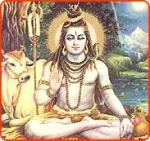
The auspicious festival of Maha Shivaratri is celebrated with devotion and religious fervor all over India and even beyond. Though fasting and worship of Shiva Linga with a ritual bath remain the common feature of Shivaratri celebrations at all places, minor variations due to regional difference can be observed in some states.
Please read on to know more about regional celebrations of Shivratri. You will be surprised to know, about the various interesting traditions and customs of Shivratri Festival and the zeal with which devotee of Lord Shiva follow them.
Shivaratri Celebrations in Various States of India
» Assam
» Himachal Pradesh
» Jammu and Kashmir
» Karnataka
» Madhya Pradesh
» Orissa
» West Bengal
Shivaratri Celebrations around the World
Andhra Pradesh
Festival of Shivaratri is observed with extreme enthusiasm in the state of Andhra Pradesh. Devotees throng the various important Shiva temples in the state mainly Sri Kalahasteshwara Temple at Kalahasti and the Bharamarambha Malikarjunaswamy Temple at Srisailam. Devotees also observe fast and chant mantras in honor of Lord Shiva to mark the auspicious festival.
Assam
In the North-Eastern state of Assam, the hub of Shivratri celebrations is at the Umananda Temple, situated on the Peacock Island in the middle of Brahamaputra river in Guwahati, the capital of Assam. Thousands of Shiva devotees from all over the country pay a visit to the temple on the occasion of Shivaratri. Sibsagar,the capital of the erstwhile Ahom kings, is the other major centre of Mahashivaratri celebrations in Assam.
Himachal Pradesh
The Temple of Bhutnath at Mandi in Himachal Pradesh is said to host the biggest Shivaratri Puja in the country. Every year on Shivratri Festival, the Governor of the state leads a Shobha Yatra at a function inaugurated by the Chief Minister. The royal family of Mandi started the tradition some 500 years ago. An eight-day-long fair is also organized which witness the participation of artists from India and even beyond.
Jammu and Kashmir
Hindus of Kashmir observe Shivaratri with utmost zeal and devotion. Here, Shivratri is celebrated for three weeks or 21 days, beginning on the first day of the dark fortnight of Phalguna (locally known as hur ukdoh) and end on the 8th day of the bright half of Phalguna. Kashmiri Brahmins perform Shivaratri puja on the 13th day of the dark half of Phalguna Krishna Paksha to mark Lord Shiva’s wedding with Uma, the beautiful daughter of the Himalayas. In keeping with their hospitable nature, Kashimiri Brahmins offer even non-vegetarian food in puja to entertain Bhairavas who are said to form the major part of Shiva’s baaraat.
Shivratri puja in Jammu and Kashmir is performed in a very distinctive way. Two pots (called kalash), depicting Shiva and Parvati are filled with walnuts soaked in water. These walnuts are taken out only on the third day which usually falls on the no moon day or amavasya. On the third day this walnut which is wet is distributed to all friends and neighbours as prasad. On the chaturdashi (14th day after full moon) there is the real feasting when the families invite each other for dinners.
In Kashmir, Shivaratri is also called Hayrath, which is the corrupt form of ‘hairat’, a Persian word meaning ‘utter surprise’. The term was coined during the Pathan occupation of the valley. Besides, Shivaratri puja is better known as Vatuk Puja in Kashimir where Vatuk means, collection or an assemblage of different objects. The name has been given because the main puja on Shivaratri day involves collection of a large number of articles. The name could also be traced to the term Vatuk Dev, Lord Shiva’s celibate form. People in Kashmir also worship Vatuk Bhairav, said to be Shiva’s most trusted dwarpal (gatekeeper). This is done in a bid to seek his favor for an audience with the Lord. On Hayrath day the children are given money as a gift called “herat kharch”. Interestingly it is not only children who receive gifts, for even husbands give gifts to their wife and the elder brother gives to younger brother. On the next day there is also a tradition to play the game of “harr” which is played with the help of sea shells.
Karnataka
Festival of Maha Shivaratri is observed with pomp and enthusiasm in the southern state of Karnataka. A grand Sri Shidlingappa’s fair is observed to mark the auspicious occasion. Deity is taken to the river in a palanquin accompanied by drummers (Dollu and Majalu) from several neighboring and is then worshipped. Linagayats, people of the Shiva cult, worship Linga on Shivaratri. Following a tradition, married women wear a linga made of silver or gold on their body. In southern Karnataka, children make believe that they are kings and dole out punishments to all and sundry. This particular tradition is based on the mythological legend related with Shivaratri that narrates the story of Shiva punishing Brahma for lying about measuring the length of Linga.
Madhya Pradesh
Shivaratri is celebrated with religious fervor in the state of Madhya Pradesh. As a tradition, people in Madhya Pradesh take a holy dip in Sagar tank in Khajuraho. The place houses a beautiful Shiva temple.
Bundelkhand Region, which has a stronghold of Shaivites hosts the biggest Shivaratri celebrations in the state. A large number of Lord Shiva devotees flock the Matangeshwar Temple and worship throughout the night. Highpoint of the Shivaratri celebrations at the Matangeshwar Temple is the 10-day-long fair that witness the participation of traders, peddlers and gypsies from other parts of the state. Display of traditional fare and a variety of handicrafts besides the rural circus show, magic shows, folk theatre, and merry-go-rounds add to the excitement.
Orissa
Festival of Maha Shivaratri is celebrated with devotion and enthusiasm in the state of Orissa. Major centres of Shivaratri celebrations in the state are Lingaraj Temple and Hakateswar Temple Atri. Shiva temples located at Mahendragiri, Gupteswar, Kapilas, Bhubaneswar and Khiching also draw a large of pilgrims from across the state.
Shivaratri celebration at Lokanath Temple, Puri is also quite popular. According to a legend popular in Orissa, long ago, Puri was a center of Shiva worship. The story goes, Lord Ramachandra himself installed the Lingam in the Lokanath Temple. This lingam is kept submerged, in a vat of water. It can only be seen on Pankodhar Ekadasi, before Shivaratri, when the water is removed from the vat. On that day, thousands of devotees come for a darshan.
West Bengal
In the state of West Bengal the festival of Maha Shivaratri is performed with great devotion and enthusiasm. On a Shivaratri day, devotees in West Bengal fast through out the day. Following the tradition, they also make four Shivlings made of clay of the holy river Ganga. These Shivlings are later offered in puja in four “prahars” (a meassure of time equal to 3 hours) of the night. In the first prahar one of the shivalings is bathed in milk. In the second period it is bathed with curd, in the third with ghee and in the fourth with honey. The devotees also stay awake the all – through the Shivaratri night. The following morning, they pray, listen to religious discourses, feed the Brahmins, offer them dakshina (alms) and finally break their fast with prasad.
At some places in West Bengal, Mahashivratri celebrations are confined to the Shiva temples. Women visit the temple carrying a copper vessel containing milk and water. They also carry with them leaves of woodapple tree, a wood apple, fruits and flowers and a lamp. As a tradition followed in many places, devotees bathe Shiva Linga with water mixed with milk. Puja is performed and fruits and flowers are offered. After Puja they return home to break their fast with fruits.
At the temple of Tarakeshwar, 57 km from Kolkata, bare-footed pilgrims carry containers filled with the sacred water of river Ganga to pour over the stone image of the Lord and decorate the granite Lingum with garlands and flowers, as a mark of their devotion.
Shivaratri Celebrations around the World
Shivaratri is celebrated by Hindus located anywhere in the world. However, celebrations are marked in countries where there is a significant Hindu population.
Mauritius
In Mauritius, Maha Shivaratri is celebrated in a big way for over three days. A large number of island’s Hindu population makes a pilgrimage to the holy volcanic lake, Grand Bassin and make food sacrifices and stockpile vessels of the holy water.
Nepal
Shivaratri is a much-anticipated festival in the Hindu kingdom of Nepal. Thousands of pilgrims and holy men from all over Southeast Asia flock Nepal weeks before the festival to worship at the Pashupatinath Temple in Kathmandu. This Lord Shiva temple is considered as one of the holiest shrines of the Hindus. To mark the festival of Mahashivaratri, devotees fast through out the day. They also take a holy bath or dip in the river on a Shivaratri morning and visit the temple to worship.
Maha Shivratri 2014
Maha Shivaratri is celebrated on the 14th night of the new moon in the Hindu month of Phalgun. In 2014, Shivaratri will celebrate on 27-February-2014 & the day is Thursday.
Followers from every part of India go to temples early in the morning. It’s an old tradition that, on Maha Shivaratri devotees has fast all day and night.
Maha Shivaratri is a big day for all the followers of Lord Shiva. Devotees wake up early in the morning take bath, and then do prayers all day.
Shivaratri is known as the “Night of Shiva”. Lord Shiva is the creator of this earth, and he has the power to destroy it. Devotees worship Lord Shiva in many forms with many names.
Whereas, the Goddess Parvati also known as Maha Shakti (Supreme Power) is a wife of Lord Shiva. Whenever, evil power arises on earth, Goddess Parvati finist it by appearing in different forms like Goddess Durga, Goddess Kali, and many more.
Maha Shivaratri has a very special significance in peoples life. According to the rituals, if a pure heart devotee perform all the holy practices accurately on Shivaratri, then he/she will become free from the circle of born and death.
The festival of Maha Shivaratri teaches us that the creater and destroyer is Lord Shiva. So we should live our life fearlessly, and treat everyone equally. We should help as many as people we can, just like Lord Shiva.
हर साल महाशिवरात्रि के शुभ अवसर पर हजारों लिटर दुध तथा अन्य पदार्थ शिवलिंग पर चढ़ाये जाते हैं। महाशिवरात्रि के अलावा भी श्रद्धालु श्री कल्याणेश्वर शिव मंदिर मंदिर में चढ़ावा चढाते हुए देखे जा सकते हैं।
पर क्या आप जानते हैं की ये सब खाद्य पदार्थ कहाँ जाते हैं? जी हाँ। यह दुध, दही, घी, शहद, अनाज पानी द्वारा बहा दिया जाता है। नागपुर में न जाने ऐसे कितने इंसान और लावारिस जानवर ऐसे हैं जिनका पेट हमारे द्वारा चढ़ाये गए और व्यर्थ बहा दिए गए अन्न से भरा जा सकता है।
भक्तों से नम्र निवेदन है की इस महाशिवरात्रि से अन्न का सदुपयोग करते हुए किसी जरूरतमंद की सहायता करें। भगवान भोलेनाथ तो आशुतोष हैं। उन्हें अपनी भक्ति से प्रसन्न कीजिये।
।। बम बम भोले ।।

